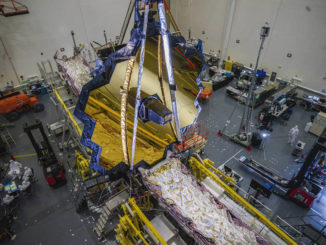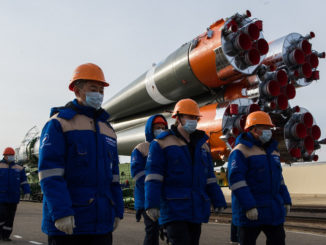
The European Space Agency’s $550 million Aeolus science mission, the product of a drawn-out 16-year development effort that required engineers to master new technologies, is in the starting blocks on a launch pad in French Guiana awaiting liftoff Wednesday to monitor wind speeds from space for the first time on a global scale.
The winds observatory’s launch Wednesday, weather permitting, will kick off a three-year mission to gather the first comprehensive worldwide measurements of wind speed — over oceans and land masses — from Earth’s surface to an altitude of nearly 100,000 feet (30 kilometers).
Data collected by the Aeolus satellite will be fed into numerical weather prediction models, replacing simulated “boundary conditions” in the computers models with near real-time measurements from space.
“We are serving the meteorological community as the primary user, but also the climate research community,” said Anders Elfving, Aeolus project manager at ESA. “For decades, there has been an outcry from these communities for explicit wind measurements, explicit wind profiles in the whole atmosphere, globally and continuously.”
Aeolus was not conceived by ESA as an operational weather satellite, but forecasters will be some of the prime beneficiaries of the mission. The mission is named for a figure in Greek mythology who was appointed by the gods as “keeper of the winds,”
We have a unique product which can be — if proven to the right quality — directly injected into the weather models,” Elfving said in a phone interview with Spaceflight Now. “Our main client is the ECMWF, the European Center for Medium Range Weather Forecasts … in the UK, and they will certainly inject our data straight into their model and get a lot of good boundary conditions for winds, which are today completely missing.”
Aeolus carries a high-power ultraviolet laser fired at 50 pulses per second toward the ground. Light emitted from the laser — the centerpiece of Aeolus’s single science instrument — will bounce off air molecules, aerosol and cloud particles, and Earth’s surface.
A tiny fraction of the scattered ultraviolet photons will reflect back toward a 5-foot (1.5-meter) telescope on the Aeolus satellite.
“Aeolus actually has its own sun on-board in the sense that it’s sending out laser light into the atmosphere, and this laser light is then scattered back from air molecules and particles in the atmosphere,” said Anne Grete Straume, ESA’s Aeolus mission scientist.

The light will return to the Aeolus satellite’s Atmospheric Laser Doppler Instrument — ALADIN — with a slightly different color. By analyzing the change in color caused by the motion of atmospheric air molecules — known as the Doppler effect — scientists can derive wind speeds.
The Doppler effect is the same process that causes an ambulance’s siren to sound different when it approaches and drives away.
“The same happens to the light which is sent out by the satellite,” Straume said in an ESA video interview. “The movement of the air molecules and the particles in its path will actually stretch or compress the light wave, and you get a different color coming back to the instrument.
“We measure the back reflection of the air and the particles at different ranges from the instrument, and from this you can actually measure the winds at different altitudes through the atmosphere from the surface up to the stratosphere,” she said. “About 30 kilometers is the top level that we will be able to measure.”
No other space mission has been able to measure winds at multiple layers of the atmosphere on a global scale. Previous satellites have been limited to deriving winds measurements by tracking the movement of clouds and aerosols, or by measuring the effect of winds on the ocean surface.
But Aeolus will be able to measure wind speeds in clear skies, eliminating the limitations of other missions. Meteorologists currently use weather balloons and airplanes for wind data, but the observations are spotty.
Wind measurements from Aeolus “will fill a significant gap in the wind observing system, particularly in the upper troposphere, the lower stratosphere, in the tropics and over the oceans, where in situ wind observations are lacking,” scientists Michael Rennie and Lars Isaksen from the ECMWF wrote in a blog post earlier this month.
As the satellite orbits nearly 200 miles (320 kilometers) above the Earth, Aeolus will point its ultraviolet laser beam at an angle of 35 degrees to the side of its ground track, in the direction away from the sun.
Aeolus will fly in a “dawn-dusk” polar orbit, meaning the spacecraft will roughly follow the boundary between day and night as it travels in a north-south direction, circling the planet every 90 minutes or so.

“We are actually shooting our laser pulse in a slant angle of 35 degrees perpendicular to the orbit, and measuring the line-of-sight return wind speed,” Elfving told Spaceflight Now. “For all purposes, the vertical winds are very small with respect to horizontal winds. So what we’ve promised to give are horizontal line-of-sight winds, which in practice means, more or less, the east-west wind all over the world. That may sound limited, but when meteorologists but that boundary condition of that vector into their overall wind models, they get 75 to 80 percent knowledge of the total wind vector.”
ESA decided to go ahead with the Aeolus mission in 2002.
“We were initially promising that we would be flying in 2007, or at least in early 2008,” said Elfving, who became Aeolus project manager in 2010. “Yes, we have had a 10-and-a-half or 11-year delay. My director said we are not ashamed at all of that. We are very proud to have sustained through all the troubles because there is actually no other comparable mission implemented in the world.”
Engineers determined Aeolus needed an ultraviolet laser to give Aeolus the capability to monitor global winds. A laser operating in visible wavelengths, such as the laser aboard the U.S.-French CALIPSO satellite, would only be tuned to track cloud motion.
Ultraviolet lasers flown in space on previous tech demo and Earth science missions have not succeeded. Most recently, an ultraviolet laser on NASA’s Cloud-Aerosol Transport System instrument on the International Space Station failed soon after it was activated in 2015.
Some of the major challenges that faced the Aeolus team included selecting materials that can cope with the high-temperature output of the laser.
“We pulse our optics 50 times every second, and this goes on year after year, and this intense pulse creates 1,700 degrees on the optical surface of the optics, and will fatigue the optics in the long run,” Elfving said. “So we have had tremendous development of the coatings of the optics to withstand this high laser pulse. We are actually our own sun.”
Managers ordered one of the most significant redesigns of the ALADIN instrument aboard Aeolus to ensure the sensor’s optical surfaces remain free of contamination.
“If there are some remaining hydrocarbons on the surface of the optics, and the UV light hits it, it will carbonize, so blacken, the surface and reduce dramatically the reflection or transmissibility of the optics,” Elfving said. “That has been a pain for many missions trying to do this.”
Despite strict clean room controls on the ground, all space missions launch with some amount of contamination, which can outgas in orbit once heated by the sun. The high-energy laser aboard Aeolus could also lead to outgassing as it warms up materials inside the ALADIN instrument.
Engineers determined they could flush the ALADIN instrument with tiny injections of pure oxygen throughout the Aeolus mission. Two high-pressure tanks carrying a combined load of around 31 pounds (14 kilograms) of liquid oxygen will gradually supply the instrument once in space.
“We have a regulation system which takes the high pressure oxygen down to an extremely low pressure in orbit — 40 to 60 pascal — which is an incredibly light pressure, very few molecules,” Elfving said.
The amount of oxygen gas inside the instrument in space will be equivalent to the oxygen produced by a small plant indoors, according to ESA.
“But it is enough to cause combustion of this organic material which always remains on the optics,” Elfving said. “It helps to catalyze and burn away that, instead of carbonizing it and blackening the optics.
“Those two, I would say, have been the main challenges — laser-induced contamination and laser-induced damage,” he added. “For the rest, we are talking about stabilities in alignment of microns or nanometers, and that’s obviously a tough challenge, especially when we are pumping a lot of energy into the laser.
“That put us between a rock and a hard place,” Elfving said. “So it has taken us about 10 years to get from a prototype laser to a flight-worthy laser with a lifetime that meets our requirements. In the beginning, due to this laser-induced contamination, we lost about 50 percent of the energy within hours, and we now we have run a laser with absolutely no degradation for six months and beyond. So we’re very confident that have achieved the state of the art.”
Concerns about the sensitivity of the Aeolus satellite’s laser instrument drove managers to transport the spacecraft from Europe to the mission’s launch base in South America by ship instead of airplane. Engineers worried the pressure increase during an airplane’s descent would damage the instrument package on Aeolus.
There are no such concerns about a pressure decrease like the conditions the spacecraft will encounter as it climbs into space.
Once the spacecraft arrived in French Guiana, teams fueled Aeolus and put the spacecraft through an extra step of cleaning. Technicians used a powerful ultraviolet torch to search for particles of dust residing on the satellite, then used a soft brush and vacuum cleaner to remove any contamination they found.
“This is a bit of a tedious task, but one that is necessary,” ESA said in a statement.
The Aeolus satellite was built by Airbus Defense and Space’s spacecraft manufacturing plant in Stevenage, England, and is based on the satellite design used by ESA’s Rosetta and Mars Express interplanetary probes. With its maneuvering fuel loaded, Aeolus weighs around 3,013 pounds (1,367 kilograms) at launch, according to Elfving.
Airbus Defense and Space’s division in Toulouse, France, developed the ALADIN instrument, and the laser transmitters were supplied by the Italian company Leonardo in Florence and Pomezia, Italy.

A Vega booster will propel the Aeolus satellite into orbit following liftoff from the European-run Guiana Space Center on the northern coast of South America. Liftoff is timed for 2120:09 GMT (5:20:09 p.m. EDT; 6:20:09 p.m. French Guiana time) Wednesday.
Powered by three Italian-built solid-fueled motors and a liquid-fueled upper stage, the Vega rocket will soar north from French Guiana to deploy Aeolus in a near-circular polar orbit around 55 minutes after liftoff.
The launch was delayed an extra day from Tuesday to Wednesday to allow for more favorable high-altitude winds over the Guiana Space Center.
Once in orbit, Aeolus will automatically extend its power-generating solar panels and begin three days of activations to prepare it for normal operations.
“Then we start switching on the laser and the instrument,” Elfving said. “That will take around two weeks if it goes well, but it could take longer because there’s a lot of tuning and observing of this high-energy laser. We don’t want to damage anything if we have any wrong settings. In October, we expect to start collecting and calibrating data.”
Scientists will meticulously compare Aeolus’s data with wind measurements collected by airplanes. The calibration campaign will extend into next year, ensuring accuracy of the satellite’s measurements.
“That will go on until the second quarter of 2019, and by that moment, we hope to have declared the quality such that meteorologists … can start ingesting our data operationally,” Elfving said.
Email the author.
Follow Stephen Clark on Twitter: @StephenClark1.



